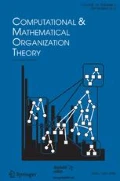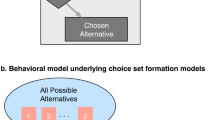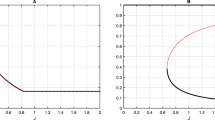Abstract
Models of segregation dynamics have examined how individual preferences over neighborhood racial composition determine macroscopic patterns of segregation. Many fewer models have considered the role of household preferences over other location attributes, which may compete with preferences over racial composition. We hypothesize that household preferences over location characteristics other than racial composition affect segregation dynamics in nonlinear ways and that, for a critical range of parameter values, these competing preferences can qualitatively affect segregation outcomes. To test this hypothesis, we develop a dynamic agent-based model that examines macro-level patterns of segregation as the result of interdependent household location choices. The model incorporates household preferences over multiple neighborhood features, some of which are endogenous to residential location patterns, and allows for income heterogeneity across races and among households of the same race. Preliminary findings indicate that patterns of segregation can emerge even when individuals are wholly indifferent to neighborhood racial composition, due to competing preferences over neighborhood density. Further, the model shows a strong tendency to concentrate affluent families in a small number of suburbs, potentially mimicking recent empirical findings on favored quarters in metropolitan areas.
Similar content being viewed by others
References
Benenson, I., I. Omer, and E. Hatna, (2002), “Entity-Based Modeling of Urban Residential Dynamics: The Case of Yaffo, Tel Aviv,” Environment and Planning B: Planning and Design, 29(4),491–512.
Bogart, W.T. and B.A. Cromwell (2000), “How Much is a Neighborhood School Worth?” Journal of Urban Economics, 47(2), 280-305.
Charles, C.Z. (2003), “The Dynamics of Racial Segregation,” Annual Review of Sociology, 29, 167–207.
Farley, J.E. (1987), “Suburbanization and Central-City Crime Rates: New Evidence and a Reinterpretation,” American Journal of Sociology, 93(3), 688–700.
Gordon, P. and H. Richardson (1997), “Are Compact Cities a Desirable Planning Goal?” Journal of the American Planning Assoc., 63(1), 95–106.
Iceland J., D.H. Weinberg, and E. Steinmentz (2002), United States Census Bureau, series CENSR-3, Racial and ethnic segregation in the United States: 1980–2000. Washington, DC: U.S. Government Printing Office.
Laurie, A J. and N.K. Jaggi (2003), “Role of ‘Vision’ in Neighborhood Racial Segregation: A Variant of the Schelling Segregation Model,” Urban Studies, 40(14), 2687–2704.
Margo, R. (1992), “Explaining the Postwar Suburbanization in the United States: The Role of Income,” Journal of Urban Economics, 31, 300–310.
Massey, D.S. and N.A. Denton (1993), American Apartheid: Segregation and the Making of the Underclass. Harvard University Press, Cambridge, MA.
Massey, D. S. and N.A. Denton (1988), “The Dimensions of Racial Segregation,” Social Forces, 67(2), 281–315.
Myrdal, G. (1944), An American Dilemma: The Negro Problem and Modern Democracy. Harper, New York.
Orfield, M. (2002), American Metropolitics: The New Suburban Reality. Washington, D.C.: The Brookings Institution Press.
O'Sullivan, D., J. Macgill, and C. Yu (2003), “Agent-Based Residential Segregation: A Hierarchically Structured Spatial Model,” presented at Agent 2003, University of Chicago, Argonne National Laboratory, October 2–4.
Schelling, T. (1978), Micromotives and Macrobehavior. Norton, New York.
Author information
Authors and Affiliations
Corresponding author
Additional information
This paper was the first runner-up for the 2004 NAACSOS best paper award.
Kan Chen is an associate professor in the Department of Computational Science at the National University of Singapore. His recent research interests include spatial and temporal scaling in driven, dissipative systems, applications of self-organized criticality, dynamics of earthquakes, and computational finance. He received a B.Sc. in physics from the University of Science and Technology of China (1983) and a Ph.D. in physics from Ohio State University (1988).
Elena Irwin is an associate professor in the Department of Agricultural, Environmental, and Development Economics at Ohio State University. Her research interests include land use change, urban sprawl, household location decisions, and the value of open space. This research applies theory and modeling techniques from the fields of spatial and regional economics, including the application of spatial econometrics and geographic information systems (GIS). She received a B.A. in German and History from Washington University in St. Louis (1988) and a Ph.D. in Agricultural and Resource Economics from the University of Maryland (1998).
Ciriyam Jayaprakash is a Professor in the Department of Physics at the Ohio State University. His recent research interests include spatially extended nonlinear systems including fully-developed turbulence, genetic regulatory networks, and applications of statistical mechanical techniques to financial and social sciences. He received an M.S. in Physics from the Indian Institute of Technology, Kanpur (1973), an M.S. in Physics from Caltech (1975) and a Ph.D in Physics from the University of Illinois at Urbana-Champaign (1979).
Keith Warren is an assistant professor in the College of Social Work at Ohio State University. His research interests focus on interpersonal interactions in the development and solution of social problems, particularly those of urban areas such as segregation, substance abuse and increased interpersonal violence. He received a B.A in Behavioral Science from Warren Wilson College (1984), and a Ph.D. in Social Work from the University of Texas at Austin (1998)
Rights and permissions
About this article
Cite this article
Chen, K., Irwin, E.G., Jayaprakash, C. et al. The Emergence of Racial Segregation in an Agent-Based Model of Residential Location: The Role of Competing Preferences. Comput Math Organiz Theor 11, 333–338 (2005). https://doi.org/10.1007/s10588-005-5588-4
Published:
Issue Date:
DOI: https://doi.org/10.1007/s10588-005-5588-4




